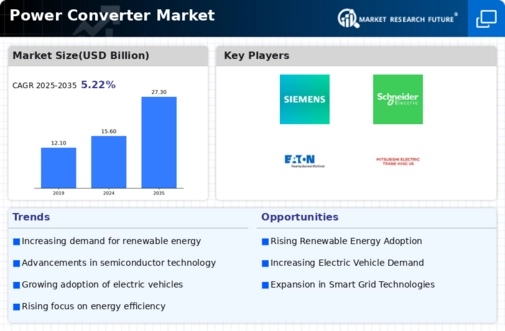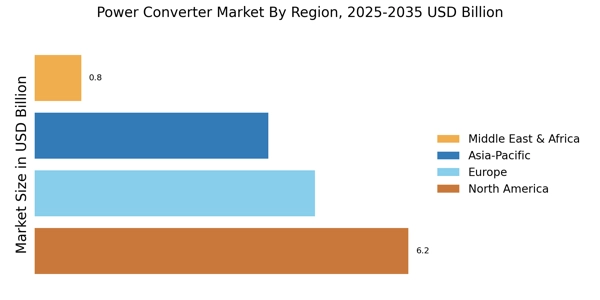Rising Demand for Electric Vehicles
The increasing adoption of electric vehicles (EVs) is a pivotal driver for the Power Converter Market. As governments and consumers alike prioritize sustainability, the demand for EVs is projected to surge. According to recent data, The Power Converter Market is expected to grow at a compound annual growth rate (CAGR) of over 20% through the next decade. This growth necessitates advanced power converters to manage the energy flow between the battery and the electric motor efficiently. Power converters play a crucial role in enhancing the performance and efficiency of EVs, thereby driving their adoption. Consequently, the Power Converter Market is likely to experience substantial growth as manufacturers innovate to meet the evolving requirements of the automotive sector.
Increased Focus on Energy Efficiency
The heightened focus on energy efficiency across various sectors is a key driver for the Power Converter Market. As energy costs continue to rise, businesses and consumers are increasingly seeking solutions that minimize energy consumption. Power converters are integral to optimizing energy use in applications ranging from consumer electronics to industrial machinery. Recent studies indicate that energy-efficient power converters can reduce energy losses by up to 30%, making them an attractive option for cost-conscious consumers. This trend is likely to stimulate demand for innovative power converter solutions that enhance energy efficiency, thereby contributing to the overall growth of the Power Converter Market.
Growth of Data Centers and Cloud Computing
The rapid growth of data centers and cloud computing services is significantly impacting the Power Converter Market. As organizations increasingly migrate to cloud-based solutions, the demand for reliable and efficient power management systems becomes paramount. Data centers require robust power converters to ensure uninterrupted power supply and to manage energy distribution effectively. The market for data centers is projected to expand at a CAGR of approximately 15% over the next few years, driven by the rising need for data storage and processing capabilities. Consequently, the Power Converter Market is poised to benefit from this trend, as power converters are essential for maintaining the operational efficiency and reliability of data center infrastructures.
Expansion of Renewable Energy Infrastructure
The ongoing expansion of renewable energy infrastructure significantly influences the Power Converter Market. As nations strive to reduce carbon emissions, investments in solar, wind, and other renewable energy sources are on the rise. Data indicates that the renewable energy sector is expected to account for nearly 50% of the global electricity generation by 2030. Power converters are essential for integrating these renewable sources into the existing grid, facilitating energy conversion and storage. This integration not only enhances grid stability but also promotes the efficient use of renewable resources. Therefore, the growth of renewable energy infrastructure is likely to propel the demand for power converters, positioning the Power Converter Market for robust expansion.
Technological Advancements in Power Electronics
Technological advancements in power electronics are reshaping the Power Converter Market. Innovations in materials, such as silicon carbide and gallium nitride, are leading to the development of more efficient and compact power converters. These advancements enable higher power densities and improved thermal management, which are critical for applications in various sectors, including telecommunications and industrial automation. The market for power electronics is projected to grow significantly, with estimates suggesting a CAGR of around 10% over the next five years. As industries seek to enhance energy efficiency and reduce operational costs, the demand for advanced power converters is expected to rise, further driving the growth of the Power Converter Market.


















Leave a Comment